Ryanair's Competitive Advantage Analysis
VerifiedAdded on 2020/02/18
|15
|2974
|157
AI Summary
This assignment requires a detailed analysis of Ryanair's competitive advantage. Students must utilize the VRIO framework to evaluate Ryanair's resources and capabilities, determining if they are valuable, rare, inimitable, and organized for sustainable competitive advantage. The analysis should focus on key aspects such as Ryanair's no-frills strategy, low-cost operation model, point-to-point service, and leadership of O'Leary. The assignment also includes appendices with additional information about the VRIO analysis and strategic capabilities.
Contribute Materials
Your contribution can guide someone’s learning journey. Share your
documents today.
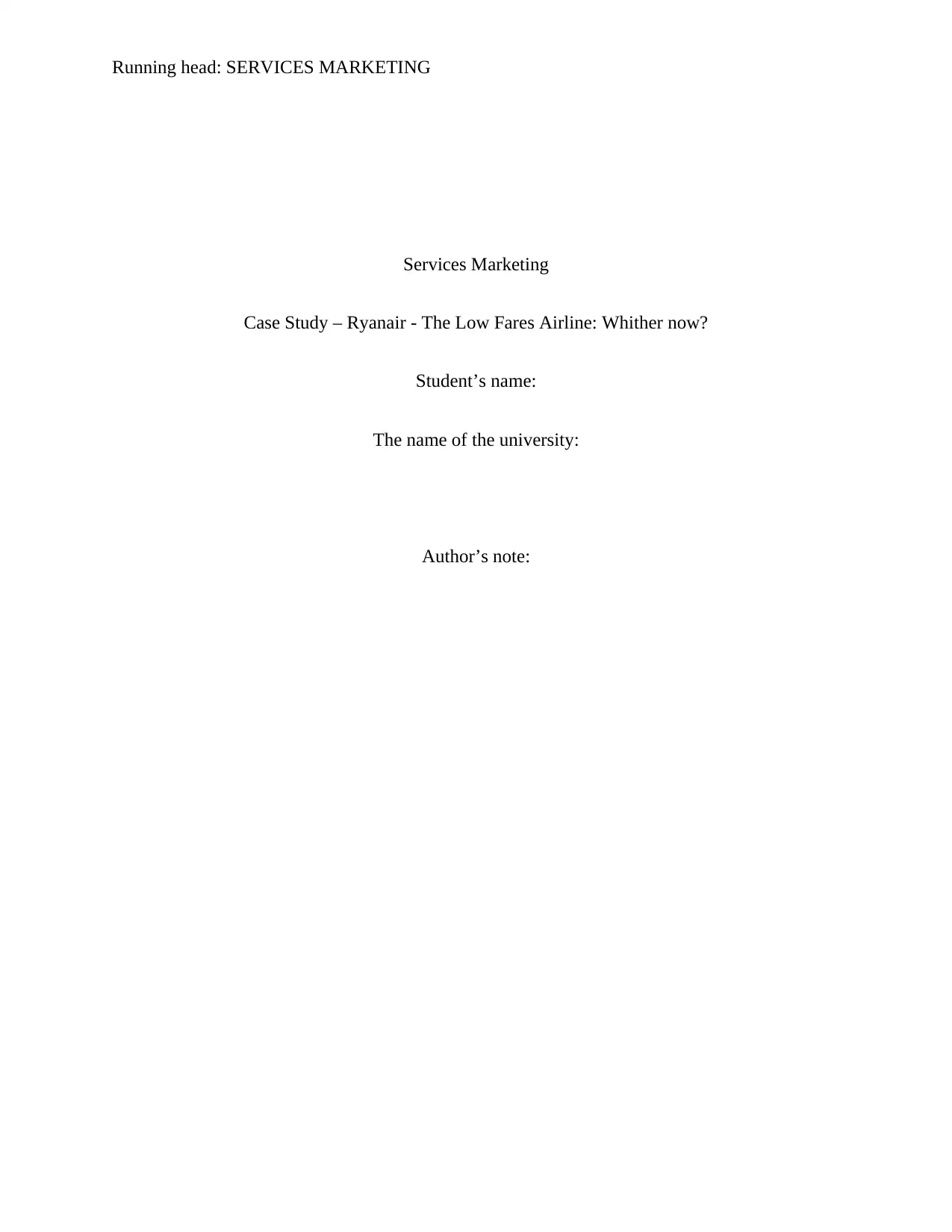
Running head: SERVICES MARKETING
Services Marketing
Case Study – Ryanair - The Low Fares Airline: Whither now?
Student’s name:
The name of the university:
Author’s note:
Services Marketing
Case Study – Ryanair - The Low Fares Airline: Whither now?
Student’s name:
The name of the university:
Author’s note:
Secure Best Marks with AI Grader
Need help grading? Try our AI Grader for instant feedback on your assignments.
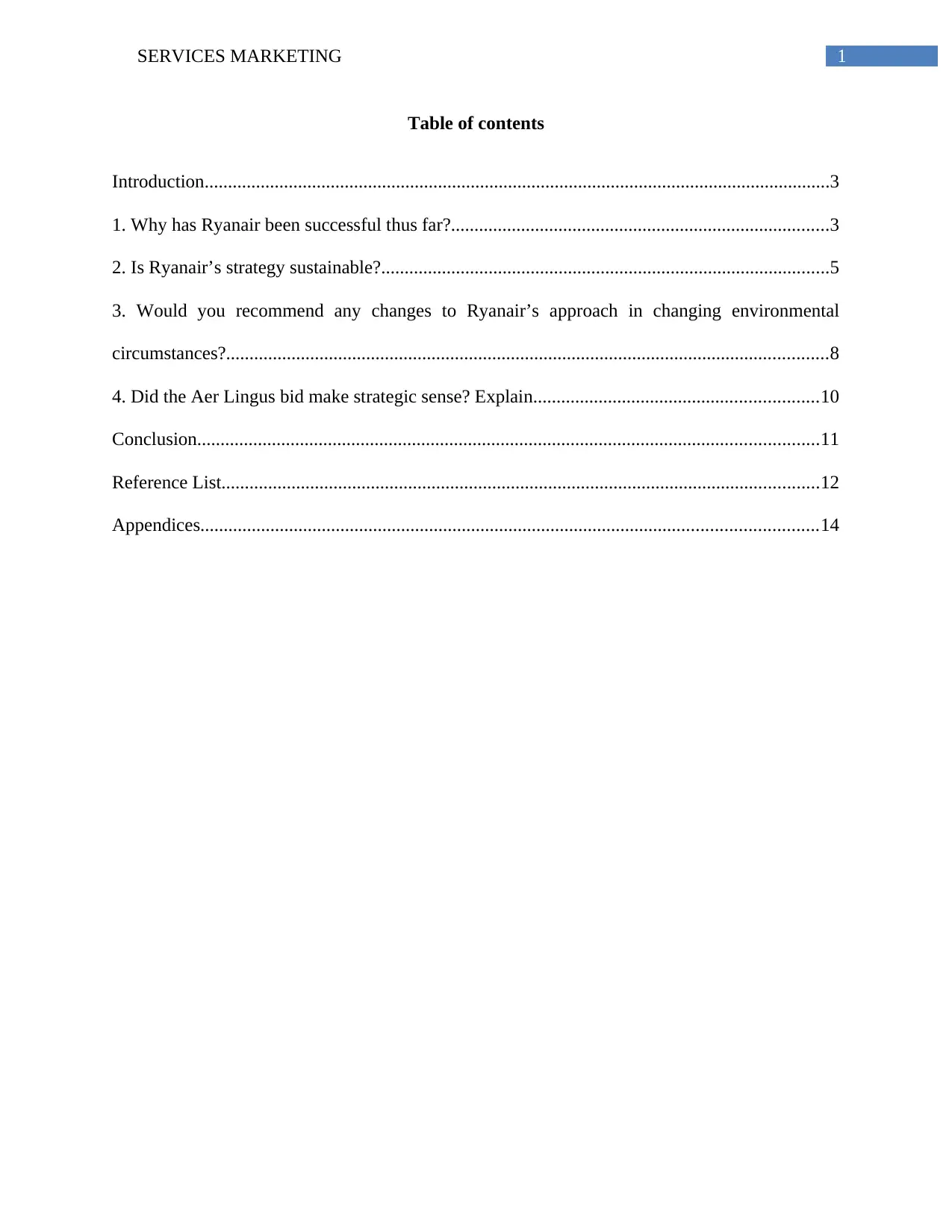
1SERVICES MARKETING
Table of contents
Introduction......................................................................................................................................3
1. Why has Ryanair been successful thus far?.................................................................................3
2. Is Ryanair’s strategy sustainable?................................................................................................5
3. Would you recommend any changes to Ryanair’s approach in changing environmental
circumstances?.................................................................................................................................8
4. Did the Aer Lingus bid make strategic sense? Explain.............................................................10
Conclusion.....................................................................................................................................11
Reference List................................................................................................................................12
Appendices....................................................................................................................................14
Table of contents
Introduction......................................................................................................................................3
1. Why has Ryanair been successful thus far?.................................................................................3
2. Is Ryanair’s strategy sustainable?................................................................................................5
3. Would you recommend any changes to Ryanair’s approach in changing environmental
circumstances?.................................................................................................................................8
4. Did the Aer Lingus bid make strategic sense? Explain.............................................................10
Conclusion.....................................................................................................................................11
Reference List................................................................................................................................12
Appendices....................................................................................................................................14
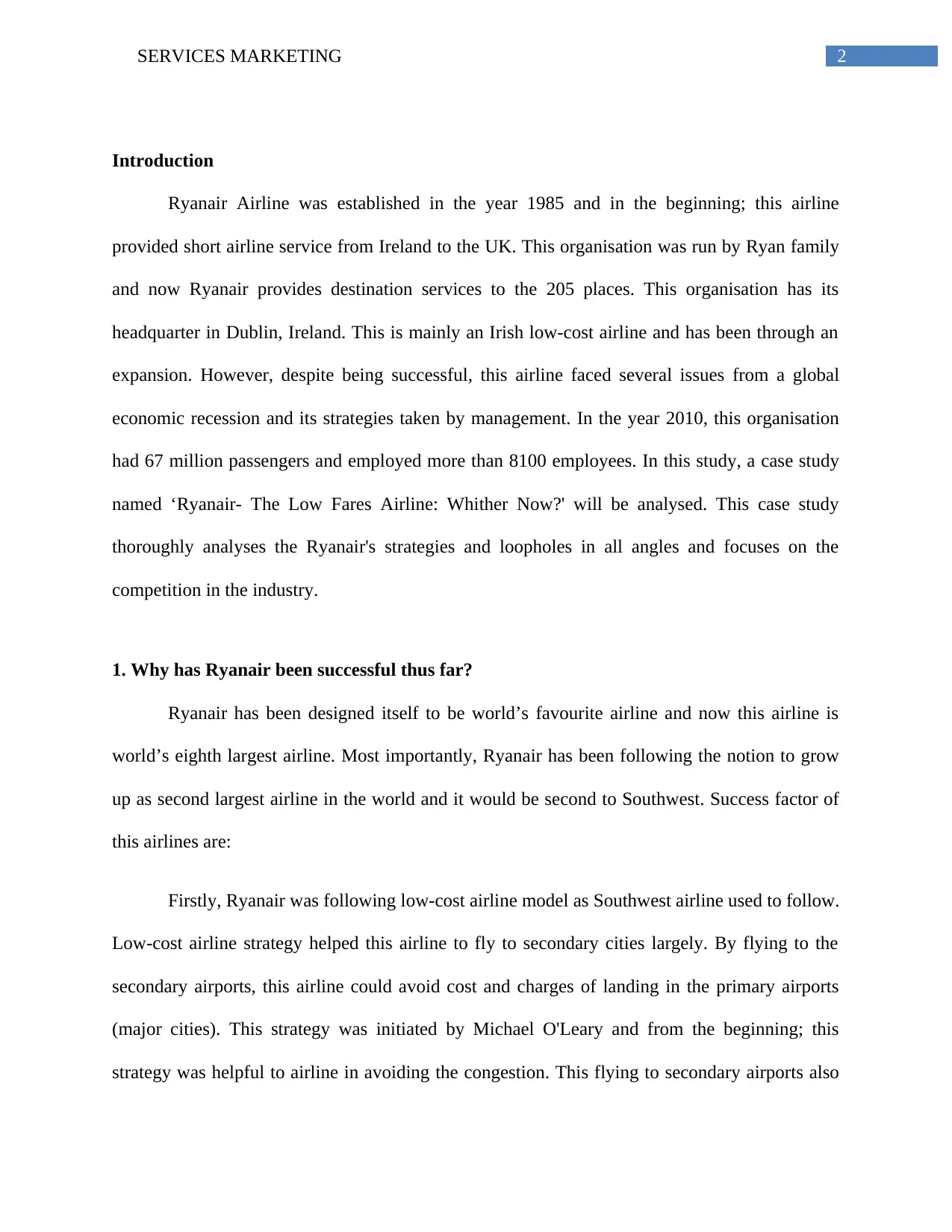
2SERVICES MARKETING
Introduction
Ryanair Airline was established in the year 1985 and in the beginning; this airline
provided short airline service from Ireland to the UK. This organisation was run by Ryan family
and now Ryanair provides destination services to the 205 places. This organisation has its
headquarter in Dublin, Ireland. This is mainly an Irish low-cost airline and has been through an
expansion. However, despite being successful, this airline faced several issues from a global
economic recession and its strategies taken by management. In the year 2010, this organisation
had 67 million passengers and employed more than 8100 employees. In this study, a case study
named ‘Ryanair- The Low Fares Airline: Whither Now?' will be analysed. This case study
thoroughly analyses the Ryanair's strategies and loopholes in all angles and focuses on the
competition in the industry.
1. Why has Ryanair been successful thus far?
Ryanair has been designed itself to be world’s favourite airline and now this airline is
world’s eighth largest airline. Most importantly, Ryanair has been following the notion to grow
up as second largest airline in the world and it would be second to Southwest. Success factor of
this airlines are:
Firstly, Ryanair was following low-cost airline model as Southwest airline used to follow.
Low-cost airline strategy helped this airline to fly to secondary cities largely. By flying to the
secondary airports, this airline could avoid cost and charges of landing in the primary airports
(major cities). This strategy was initiated by Michael O'Leary and from the beginning; this
strategy was helpful to airline in avoiding the congestion. This flying to secondary airports also
Introduction
Ryanair Airline was established in the year 1985 and in the beginning; this airline
provided short airline service from Ireland to the UK. This organisation was run by Ryan family
and now Ryanair provides destination services to the 205 places. This organisation has its
headquarter in Dublin, Ireland. This is mainly an Irish low-cost airline and has been through an
expansion. However, despite being successful, this airline faced several issues from a global
economic recession and its strategies taken by management. In the year 2010, this organisation
had 67 million passengers and employed more than 8100 employees. In this study, a case study
named ‘Ryanair- The Low Fares Airline: Whither Now?' will be analysed. This case study
thoroughly analyses the Ryanair's strategies and loopholes in all angles and focuses on the
competition in the industry.
1. Why has Ryanair been successful thus far?
Ryanair has been designed itself to be world’s favourite airline and now this airline is
world’s eighth largest airline. Most importantly, Ryanair has been following the notion to grow
up as second largest airline in the world and it would be second to Southwest. Success factor of
this airlines are:
Firstly, Ryanair was following low-cost airline model as Southwest airline used to follow.
Low-cost airline strategy helped this airline to fly to secondary cities largely. By flying to the
secondary airports, this airline could avoid cost and charges of landing in the primary airports
(major cities). This strategy was initiated by Michael O'Leary and from the beginning; this
strategy was helpful to airline in avoiding the congestion. This flying to secondary airports also

3SERVICES MARKETING
helped the airlines to improve turn-out time as it assisted the each aeroplane to land on time. This
on-time arrival helped to develop customer satisfaction. Additionally, this airline always gave
importance in point-to-point services that could eliminate the operation like baggage and transfer
(O’Connell et al. 2015).
Secondly, Ryanair followed the contrarian strategy that enables an organisation to invest
in a section that goes against the market trends. This contrarian strategy is all about to invest in
an asset that does not make a profit right now; however, investor can sell this asset when the
right time would come (Casadesus-Masanell and Ricart 2014). During the time of 2009, all the
airline's companies were removing the flights, cutting the prices; O'Leary was buying new
aircraft and exploring new routes for services. In the year 2010, O'Leary published the profit
percentage and it clearly showed that the airline made 200 percent profit. This contrarian strategy
helped Ryanair to attract more customers and overshadowed the competitors.
Thirdly, Ryanair took strategy to provide ancillary services to the passengers of Ryanair
with the airline flight service. This strategy included the services of in-flight beverages,
merchandise products, food items and internet based products. In addition, Ryanair decided to
provide customers with the service of car rentals, accommodation and travel insurance through
the website. This strategy assists to reduce unit cost and ancillary revenues were 28% of the total
profit (Malighetti et al. 2013). Later, Ryanair included online gambling, in-flight mobile phone
services to the customers during flight.
Fourth, Michael O'Leary was a key person behind the success of Ryanair and this airline
first introduced the services of low-cost airline. This visionary leader understood the Southwest
model and started a low-fare airline in the Europe. Before O'Leary, Ryanair was a small airline
helped the airlines to improve turn-out time as it assisted the each aeroplane to land on time. This
on-time arrival helped to develop customer satisfaction. Additionally, this airline always gave
importance in point-to-point services that could eliminate the operation like baggage and transfer
(O’Connell et al. 2015).
Secondly, Ryanair followed the contrarian strategy that enables an organisation to invest
in a section that goes against the market trends. This contrarian strategy is all about to invest in
an asset that does not make a profit right now; however, investor can sell this asset when the
right time would come (Casadesus-Masanell and Ricart 2014). During the time of 2009, all the
airline's companies were removing the flights, cutting the prices; O'Leary was buying new
aircraft and exploring new routes for services. In the year 2010, O'Leary published the profit
percentage and it clearly showed that the airline made 200 percent profit. This contrarian strategy
helped Ryanair to attract more customers and overshadowed the competitors.
Thirdly, Ryanair took strategy to provide ancillary services to the passengers of Ryanair
with the airline flight service. This strategy included the services of in-flight beverages,
merchandise products, food items and internet based products. In addition, Ryanair decided to
provide customers with the service of car rentals, accommodation and travel insurance through
the website. This strategy assists to reduce unit cost and ancillary revenues were 28% of the total
profit (Malighetti et al. 2013). Later, Ryanair included online gambling, in-flight mobile phone
services to the customers during flight.
Fourth, Michael O'Leary was a key person behind the success of Ryanair and this airline
first introduced the services of low-cost airline. This visionary leader understood the Southwest
model and started a low-fare airline in the Europe. Before O'Leary, Ryanair was a small airline
Secure Best Marks with AI Grader
Need help grading? Try our AI Grader for instant feedback on your assignments.
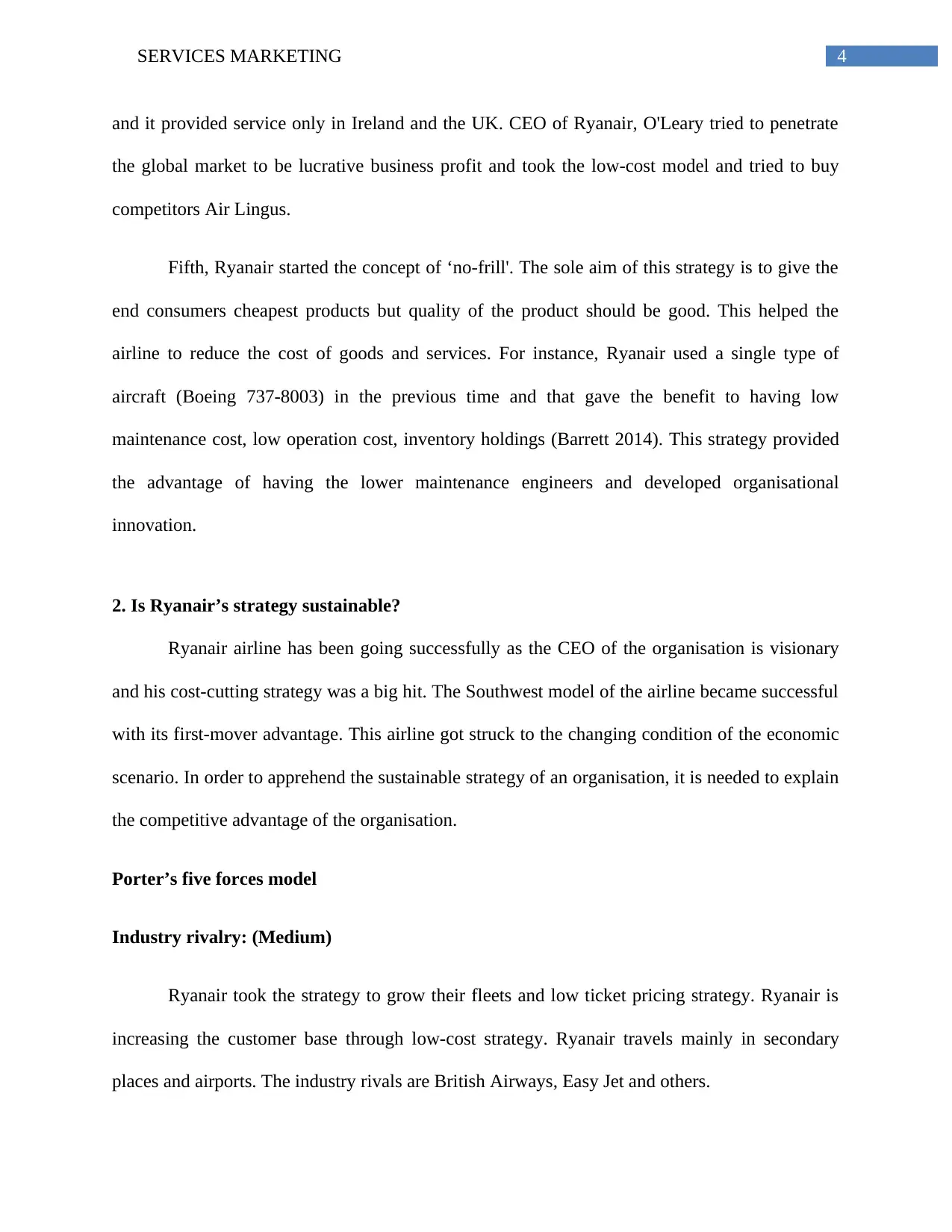
4SERVICES MARKETING
and it provided service only in Ireland and the UK. CEO of Ryanair, O'Leary tried to penetrate
the global market to be lucrative business profit and took the low-cost model and tried to buy
competitors Air Lingus.
Fifth, Ryanair started the concept of ‘no-frill'. The sole aim of this strategy is to give the
end consumers cheapest products but quality of the product should be good. This helped the
airline to reduce the cost of goods and services. For instance, Ryanair used a single type of
aircraft (Boeing 737-8003) in the previous time and that gave the benefit to having low
maintenance cost, low operation cost, inventory holdings (Barrett 2014). This strategy provided
the advantage of having the lower maintenance engineers and developed organisational
innovation.
2. Is Ryanair’s strategy sustainable?
Ryanair airline has been going successfully as the CEO of the organisation is visionary
and his cost-cutting strategy was a big hit. The Southwest model of the airline became successful
with its first-mover advantage. This airline got struck to the changing condition of the economic
scenario. In order to apprehend the sustainable strategy of an organisation, it is needed to explain
the competitive advantage of the organisation.
Porter’s five forces model
Industry rivalry: (Medium)
Ryanair took the strategy to grow their fleets and low ticket pricing strategy. Ryanair is
increasing the customer base through low-cost strategy. Ryanair travels mainly in secondary
places and airports. The industry rivals are British Airways, Easy Jet and others.
and it provided service only in Ireland and the UK. CEO of Ryanair, O'Leary tried to penetrate
the global market to be lucrative business profit and took the low-cost model and tried to buy
competitors Air Lingus.
Fifth, Ryanair started the concept of ‘no-frill'. The sole aim of this strategy is to give the
end consumers cheapest products but quality of the product should be good. This helped the
airline to reduce the cost of goods and services. For instance, Ryanair used a single type of
aircraft (Boeing 737-8003) in the previous time and that gave the benefit to having low
maintenance cost, low operation cost, inventory holdings (Barrett 2014). This strategy provided
the advantage of having the lower maintenance engineers and developed organisational
innovation.
2. Is Ryanair’s strategy sustainable?
Ryanair airline has been going successfully as the CEO of the organisation is visionary
and his cost-cutting strategy was a big hit. The Southwest model of the airline became successful
with its first-mover advantage. This airline got struck to the changing condition of the economic
scenario. In order to apprehend the sustainable strategy of an organisation, it is needed to explain
the competitive advantage of the organisation.
Porter’s five forces model
Industry rivalry: (Medium)
Ryanair took the strategy to grow their fleets and low ticket pricing strategy. Ryanair is
increasing the customer base through low-cost strategy. Ryanair travels mainly in secondary
places and airports. The industry rivals are British Airways, Easy Jet and others.
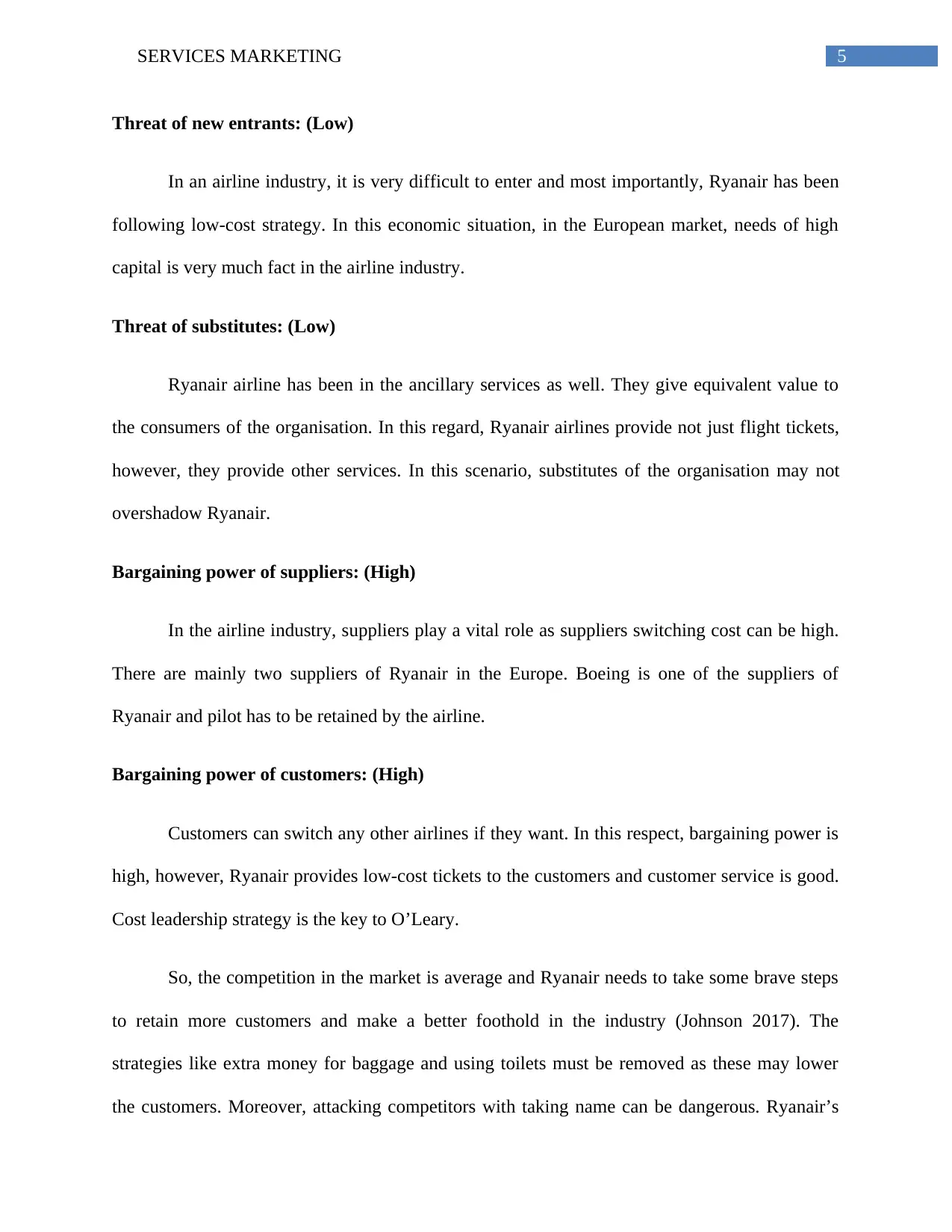
5SERVICES MARKETING
Threat of new entrants: (Low)
In an airline industry, it is very difficult to enter and most importantly, Ryanair has been
following low-cost strategy. In this economic situation, in the European market, needs of high
capital is very much fact in the airline industry.
Threat of substitutes: (Low)
Ryanair airline has been in the ancillary services as well. They give equivalent value to
the consumers of the organisation. In this regard, Ryanair airlines provide not just flight tickets,
however, they provide other services. In this scenario, substitutes of the organisation may not
overshadow Ryanair.
Bargaining power of suppliers: (High)
In the airline industry, suppliers play a vital role as suppliers switching cost can be high.
There are mainly two suppliers of Ryanair in the Europe. Boeing is one of the suppliers of
Ryanair and pilot has to be retained by the airline.
Bargaining power of customers: (High)
Customers can switch any other airlines if they want. In this respect, bargaining power is
high, however, Ryanair provides low-cost tickets to the customers and customer service is good.
Cost leadership strategy is the key to O’Leary.
So, the competition in the market is average and Ryanair needs to take some brave steps
to retain more customers and make a better foothold in the industry (Johnson 2017). The
strategies like extra money for baggage and using toilets must be removed as these may lower
the customers. Moreover, attacking competitors with taking name can be dangerous. Ryanair’s
Threat of new entrants: (Low)
In an airline industry, it is very difficult to enter and most importantly, Ryanair has been
following low-cost strategy. In this economic situation, in the European market, needs of high
capital is very much fact in the airline industry.
Threat of substitutes: (Low)
Ryanair airline has been in the ancillary services as well. They give equivalent value to
the consumers of the organisation. In this regard, Ryanair airlines provide not just flight tickets,
however, they provide other services. In this scenario, substitutes of the organisation may not
overshadow Ryanair.
Bargaining power of suppliers: (High)
In the airline industry, suppliers play a vital role as suppliers switching cost can be high.
There are mainly two suppliers of Ryanair in the Europe. Boeing is one of the suppliers of
Ryanair and pilot has to be retained by the airline.
Bargaining power of customers: (High)
Customers can switch any other airlines if they want. In this respect, bargaining power is
high, however, Ryanair provides low-cost tickets to the customers and customer service is good.
Cost leadership strategy is the key to O’Leary.
So, the competition in the market is average and Ryanair needs to take some brave steps
to retain more customers and make a better foothold in the industry (Johnson 2017). The
strategies like extra money for baggage and using toilets must be removed as these may lower
the customers. Moreover, attacking competitors with taking name can be dangerous. Ryanair’s

6SERVICES MARKETING
campaigning of ‘Bye-Bye Lufthansa’ was not successful. The organisation can take CSR
strategy in order to sustain in the market. The strategy of green fuel and products that make the
environment sustainable would be helpful strategies that attract more customers. Moreover,
researched and surveys showed that customers want more comfort and legroom in the flight
(Borenstein and Rose 2014). Cost conscious culture of the organisation and policies regarding
them would be helpful for the organisation to grow.
SWOT analysis
Strengths
Young aircraft
Point-to-point services
Low operation cost
Low-cost services
Marketing model
R&D on aircraft development
Weaknesses
Customer services
Public image
Working condition
Choices of destinations
Opportunities
Expansion in the market
Modern technology
Competition committee
Threats
Substitute transportation
Substitute in the industry
Legal issues
CSR activities
Fuel price
Table: SWOT analysis
(Source: Self-developed)
campaigning of ‘Bye-Bye Lufthansa’ was not successful. The organisation can take CSR
strategy in order to sustain in the market. The strategy of green fuel and products that make the
environment sustainable would be helpful strategies that attract more customers. Moreover,
researched and surveys showed that customers want more comfort and legroom in the flight
(Borenstein and Rose 2014). Cost conscious culture of the organisation and policies regarding
them would be helpful for the organisation to grow.
SWOT analysis
Strengths
Young aircraft
Point-to-point services
Low operation cost
Low-cost services
Marketing model
R&D on aircraft development
Weaknesses
Customer services
Public image
Working condition
Choices of destinations
Opportunities
Expansion in the market
Modern technology
Competition committee
Threats
Substitute transportation
Substitute in the industry
Legal issues
CSR activities
Fuel price
Table: SWOT analysis
(Source: Self-developed)
Paraphrase This Document
Need a fresh take? Get an instant paraphrase of this document with our AI Paraphraser
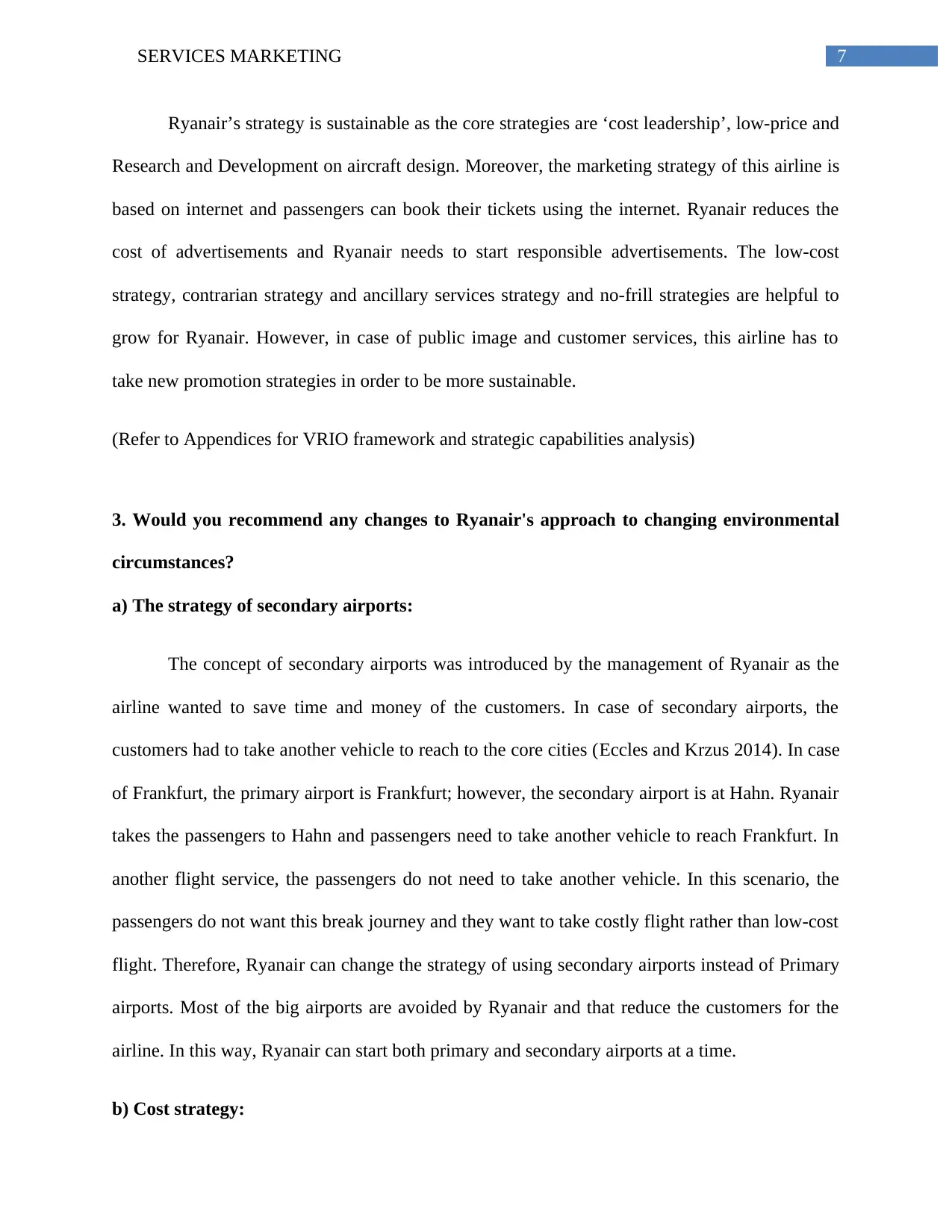
7SERVICES MARKETING
Ryanair’s strategy is sustainable as the core strategies are ‘cost leadership’, low-price and
Research and Development on aircraft design. Moreover, the marketing strategy of this airline is
based on internet and passengers can book their tickets using the internet. Ryanair reduces the
cost of advertisements and Ryanair needs to start responsible advertisements. The low-cost
strategy, contrarian strategy and ancillary services strategy and no-frill strategies are helpful to
grow for Ryanair. However, in case of public image and customer services, this airline has to
take new promotion strategies in order to be more sustainable.
(Refer to Appendices for VRIO framework and strategic capabilities analysis)
3. Would you recommend any changes to Ryanair's approach to changing environmental
circumstances?
a) The strategy of secondary airports:
The concept of secondary airports was introduced by the management of Ryanair as the
airline wanted to save time and money of the customers. In case of secondary airports, the
customers had to take another vehicle to reach to the core cities (Eccles and Krzus 2014). In case
of Frankfurt, the primary airport is Frankfurt; however, the secondary airport is at Hahn. Ryanair
takes the passengers to Hahn and passengers need to take another vehicle to reach Frankfurt. In
another flight service, the passengers do not need to take another vehicle. In this scenario, the
passengers do not want this break journey and they want to take costly flight rather than low-cost
flight. Therefore, Ryanair can change the strategy of using secondary airports instead of Primary
airports. Most of the big airports are avoided by Ryanair and that reduce the customers for the
airline. In this way, Ryanair can start both primary and secondary airports at a time.
b) Cost strategy:
Ryanair’s strategy is sustainable as the core strategies are ‘cost leadership’, low-price and
Research and Development on aircraft design. Moreover, the marketing strategy of this airline is
based on internet and passengers can book their tickets using the internet. Ryanair reduces the
cost of advertisements and Ryanair needs to start responsible advertisements. The low-cost
strategy, contrarian strategy and ancillary services strategy and no-frill strategies are helpful to
grow for Ryanair. However, in case of public image and customer services, this airline has to
take new promotion strategies in order to be more sustainable.
(Refer to Appendices for VRIO framework and strategic capabilities analysis)
3. Would you recommend any changes to Ryanair's approach to changing environmental
circumstances?
a) The strategy of secondary airports:
The concept of secondary airports was introduced by the management of Ryanair as the
airline wanted to save time and money of the customers. In case of secondary airports, the
customers had to take another vehicle to reach to the core cities (Eccles and Krzus 2014). In case
of Frankfurt, the primary airport is Frankfurt; however, the secondary airport is at Hahn. Ryanair
takes the passengers to Hahn and passengers need to take another vehicle to reach Frankfurt. In
another flight service, the passengers do not need to take another vehicle. In this scenario, the
passengers do not want this break journey and they want to take costly flight rather than low-cost
flight. Therefore, Ryanair can change the strategy of using secondary airports instead of Primary
airports. Most of the big airports are avoided by Ryanair and that reduce the customers for the
airline. In this way, Ryanair can start both primary and secondary airports at a time.
b) Cost strategy:
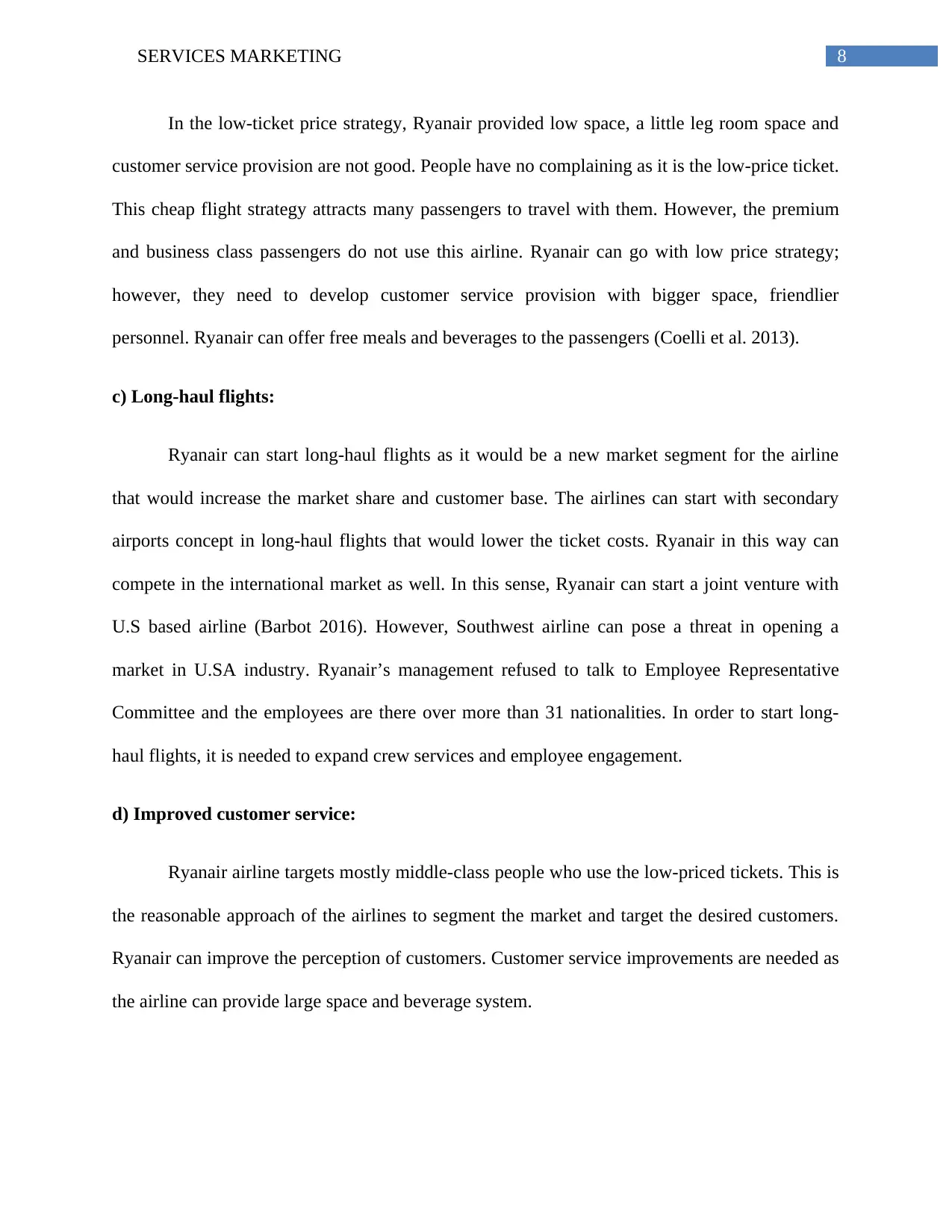
8SERVICES MARKETING
In the low-ticket price strategy, Ryanair provided low space, a little leg room space and
customer service provision are not good. People have no complaining as it is the low-price ticket.
This cheap flight strategy attracts many passengers to travel with them. However, the premium
and business class passengers do not use this airline. Ryanair can go with low price strategy;
however, they need to develop customer service provision with bigger space, friendlier
personnel. Ryanair can offer free meals and beverages to the passengers (Coelli et al. 2013).
c) Long-haul flights:
Ryanair can start long-haul flights as it would be a new market segment for the airline
that would increase the market share and customer base. The airlines can start with secondary
airports concept in long-haul flights that would lower the ticket costs. Ryanair in this way can
compete in the international market as well. In this sense, Ryanair can start a joint venture with
U.S based airline (Barbot 2016). However, Southwest airline can pose a threat in opening a
market in U.SA industry. Ryanair’s management refused to talk to Employee Representative
Committee and the employees are there over more than 31 nationalities. In order to start long-
haul flights, it is needed to expand crew services and employee engagement.
d) Improved customer service:
Ryanair airline targets mostly middle-class people who use the low-priced tickets. This is
the reasonable approach of the airlines to segment the market and target the desired customers.
Ryanair can improve the perception of customers. Customer service improvements are needed as
the airline can provide large space and beverage system.
In the low-ticket price strategy, Ryanair provided low space, a little leg room space and
customer service provision are not good. People have no complaining as it is the low-price ticket.
This cheap flight strategy attracts many passengers to travel with them. However, the premium
and business class passengers do not use this airline. Ryanair can go with low price strategy;
however, they need to develop customer service provision with bigger space, friendlier
personnel. Ryanair can offer free meals and beverages to the passengers (Coelli et al. 2013).
c) Long-haul flights:
Ryanair can start long-haul flights as it would be a new market segment for the airline
that would increase the market share and customer base. The airlines can start with secondary
airports concept in long-haul flights that would lower the ticket costs. Ryanair in this way can
compete in the international market as well. In this sense, Ryanair can start a joint venture with
U.S based airline (Barbot 2016). However, Southwest airline can pose a threat in opening a
market in U.SA industry. Ryanair’s management refused to talk to Employee Representative
Committee and the employees are there over more than 31 nationalities. In order to start long-
haul flights, it is needed to expand crew services and employee engagement.
d) Improved customer service:
Ryanair airline targets mostly middle-class people who use the low-priced tickets. This is
the reasonable approach of the airlines to segment the market and target the desired customers.
Ryanair can improve the perception of customers. Customer service improvements are needed as
the airline can provide large space and beverage system.
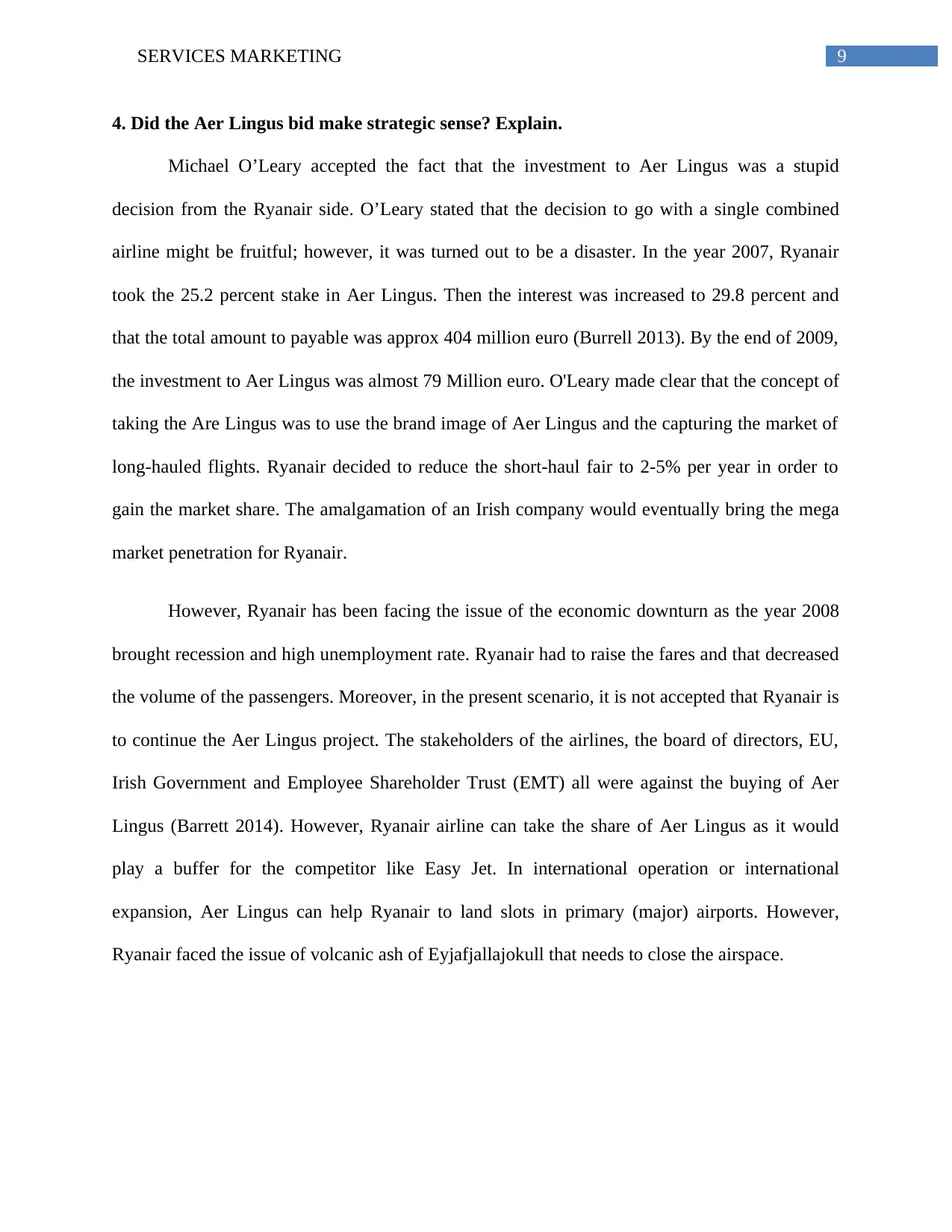
9SERVICES MARKETING
4. Did the Aer Lingus bid make strategic sense? Explain.
Michael O’Leary accepted the fact that the investment to Aer Lingus was a stupid
decision from the Ryanair side. O’Leary stated that the decision to go with a single combined
airline might be fruitful; however, it was turned out to be a disaster. In the year 2007, Ryanair
took the 25.2 percent stake in Aer Lingus. Then the interest was increased to 29.8 percent and
that the total amount to payable was approx 404 million euro (Burrell 2013). By the end of 2009,
the investment to Aer Lingus was almost 79 Million euro. O'Leary made clear that the concept of
taking the Are Lingus was to use the brand image of Aer Lingus and the capturing the market of
long-hauled flights. Ryanair decided to reduce the short-haul fair to 2-5% per year in order to
gain the market share. The amalgamation of an Irish company would eventually bring the mega
market penetration for Ryanair.
However, Ryanair has been facing the issue of the economic downturn as the year 2008
brought recession and high unemployment rate. Ryanair had to raise the fares and that decreased
the volume of the passengers. Moreover, in the present scenario, it is not accepted that Ryanair is
to continue the Aer Lingus project. The stakeholders of the airlines, the board of directors, EU,
Irish Government and Employee Shareholder Trust (EMT) all were against the buying of Aer
Lingus (Barrett 2014). However, Ryanair airline can take the share of Aer Lingus as it would
play a buffer for the competitor like Easy Jet. In international operation or international
expansion, Aer Lingus can help Ryanair to land slots in primary (major) airports. However,
Ryanair faced the issue of volcanic ash of Eyjafjallajokull that needs to close the airspace.
4. Did the Aer Lingus bid make strategic sense? Explain.
Michael O’Leary accepted the fact that the investment to Aer Lingus was a stupid
decision from the Ryanair side. O’Leary stated that the decision to go with a single combined
airline might be fruitful; however, it was turned out to be a disaster. In the year 2007, Ryanair
took the 25.2 percent stake in Aer Lingus. Then the interest was increased to 29.8 percent and
that the total amount to payable was approx 404 million euro (Burrell 2013). By the end of 2009,
the investment to Aer Lingus was almost 79 Million euro. O'Leary made clear that the concept of
taking the Are Lingus was to use the brand image of Aer Lingus and the capturing the market of
long-hauled flights. Ryanair decided to reduce the short-haul fair to 2-5% per year in order to
gain the market share. The amalgamation of an Irish company would eventually bring the mega
market penetration for Ryanair.
However, Ryanair has been facing the issue of the economic downturn as the year 2008
brought recession and high unemployment rate. Ryanair had to raise the fares and that decreased
the volume of the passengers. Moreover, in the present scenario, it is not accepted that Ryanair is
to continue the Aer Lingus project. The stakeholders of the airlines, the board of directors, EU,
Irish Government and Employee Shareholder Trust (EMT) all were against the buying of Aer
Lingus (Barrett 2014). However, Ryanair airline can take the share of Aer Lingus as it would
play a buffer for the competitor like Easy Jet. In international operation or international
expansion, Aer Lingus can help Ryanair to land slots in primary (major) airports. However,
Ryanair faced the issue of volcanic ash of Eyjafjallajokull that needs to close the airspace.
Secure Best Marks with AI Grader
Need help grading? Try our AI Grader for instant feedback on your assignments.

10SERVICES MARKETING
Conclusion
It is observed that Ryanair has been facing the issues of the economic downturn that may
impact on the growth with reducing planned fleet expansion. Most of the all, Ryanair needs to
make international industrial relation that may cause financial losses. Ryanair bullied some of the
Aer Lingus pilots that caused another issue. In order to solve the issue, customer service
provision and spaces in flights need to improve. Moreover, the environmental impact of CSR
strategies can be taken that can improve the sustainability of the airline.
Conclusion
It is observed that Ryanair has been facing the issues of the economic downturn that may
impact on the growth with reducing planned fleet expansion. Most of the all, Ryanair needs to
make international industrial relation that may cause financial losses. Ryanair bullied some of the
Aer Lingus pilots that caused another issue. In order to solve the issue, customer service
provision and spaces in flights need to improve. Moreover, the environmental impact of CSR
strategies can be taken that can improve the sustainability of the airline.
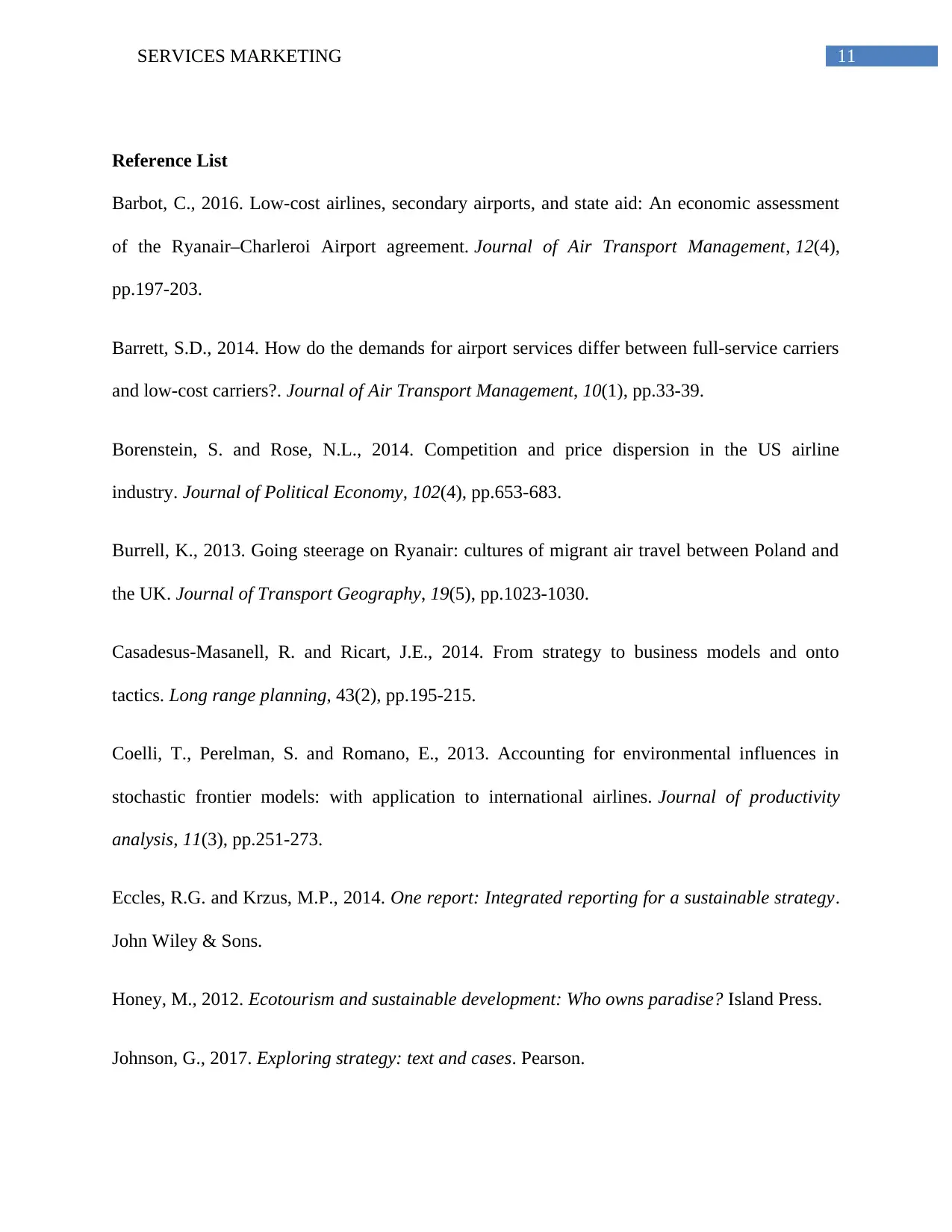
11SERVICES MARKETING
Reference List
Barbot, C., 2016. Low-cost airlines, secondary airports, and state aid: An economic assessment
of the Ryanair–Charleroi Airport agreement. Journal of Air Transport Management, 12(4),
pp.197-203.
Barrett, S.D., 2014. How do the demands for airport services differ between full-service carriers
and low-cost carriers?. Journal of Air Transport Management, 10(1), pp.33-39.
Borenstein, S. and Rose, N.L., 2014. Competition and price dispersion in the US airline
industry. Journal of Political Economy, 102(4), pp.653-683.
Burrell, K., 2013. Going steerage on Ryanair: cultures of migrant air travel between Poland and
the UK. Journal of Transport Geography, 19(5), pp.1023-1030.
Casadesus-Masanell, R. and Ricart, J.E., 2014. From strategy to business models and onto
tactics. Long range planning, 43(2), pp.195-215.
Coelli, T., Perelman, S. and Romano, E., 2013. Accounting for environmental influences in
stochastic frontier models: with application to international airlines. Journal of productivity
analysis, 11(3), pp.251-273.
Eccles, R.G. and Krzus, M.P., 2014. One report: Integrated reporting for a sustainable strategy.
John Wiley & Sons.
Honey, M., 2012. Ecotourism and sustainable development: Who owns paradise? Island Press.
Johnson, G., 2017. Exploring strategy: text and cases. Pearson.
Reference List
Barbot, C., 2016. Low-cost airlines, secondary airports, and state aid: An economic assessment
of the Ryanair–Charleroi Airport agreement. Journal of Air Transport Management, 12(4),
pp.197-203.
Barrett, S.D., 2014. How do the demands for airport services differ between full-service carriers
and low-cost carriers?. Journal of Air Transport Management, 10(1), pp.33-39.
Borenstein, S. and Rose, N.L., 2014. Competition and price dispersion in the US airline
industry. Journal of Political Economy, 102(4), pp.653-683.
Burrell, K., 2013. Going steerage on Ryanair: cultures of migrant air travel between Poland and
the UK. Journal of Transport Geography, 19(5), pp.1023-1030.
Casadesus-Masanell, R. and Ricart, J.E., 2014. From strategy to business models and onto
tactics. Long range planning, 43(2), pp.195-215.
Coelli, T., Perelman, S. and Romano, E., 2013. Accounting for environmental influences in
stochastic frontier models: with application to international airlines. Journal of productivity
analysis, 11(3), pp.251-273.
Eccles, R.G. and Krzus, M.P., 2014. One report: Integrated reporting for a sustainable strategy.
John Wiley & Sons.
Honey, M., 2012. Ecotourism and sustainable development: Who owns paradise? Island Press.
Johnson, G., 2017. Exploring strategy: text and cases. Pearson.

12SERVICES MARKETING
Malighetti, P., Paleari, S. and Redondi, R., 2013. Pricing strategies of low-cost airlines: The
Ryanair case study. Journal of Air Transport Management, 15(4), pp.195-203.
O’Connell, J.F. and Williams, G., 2015. Passengers’ perceptions of low cost airlines and full
service carriers: A case study involving Ryanair, Aer Lingus, Air Asia and Malaysia
Airlines. Journal of Air Transport Management, 11(4), pp.259-272.
Malighetti, P., Paleari, S. and Redondi, R., 2013. Pricing strategies of low-cost airlines: The
Ryanair case study. Journal of Air Transport Management, 15(4), pp.195-203.
O’Connell, J.F. and Williams, G., 2015. Passengers’ perceptions of low cost airlines and full
service carriers: A case study involving Ryanair, Aer Lingus, Air Asia and Malaysia
Airlines. Journal of Air Transport Management, 11(4), pp.259-272.
Paraphrase This Document
Need a fresh take? Get an instant paraphrase of this document with our AI Paraphraser
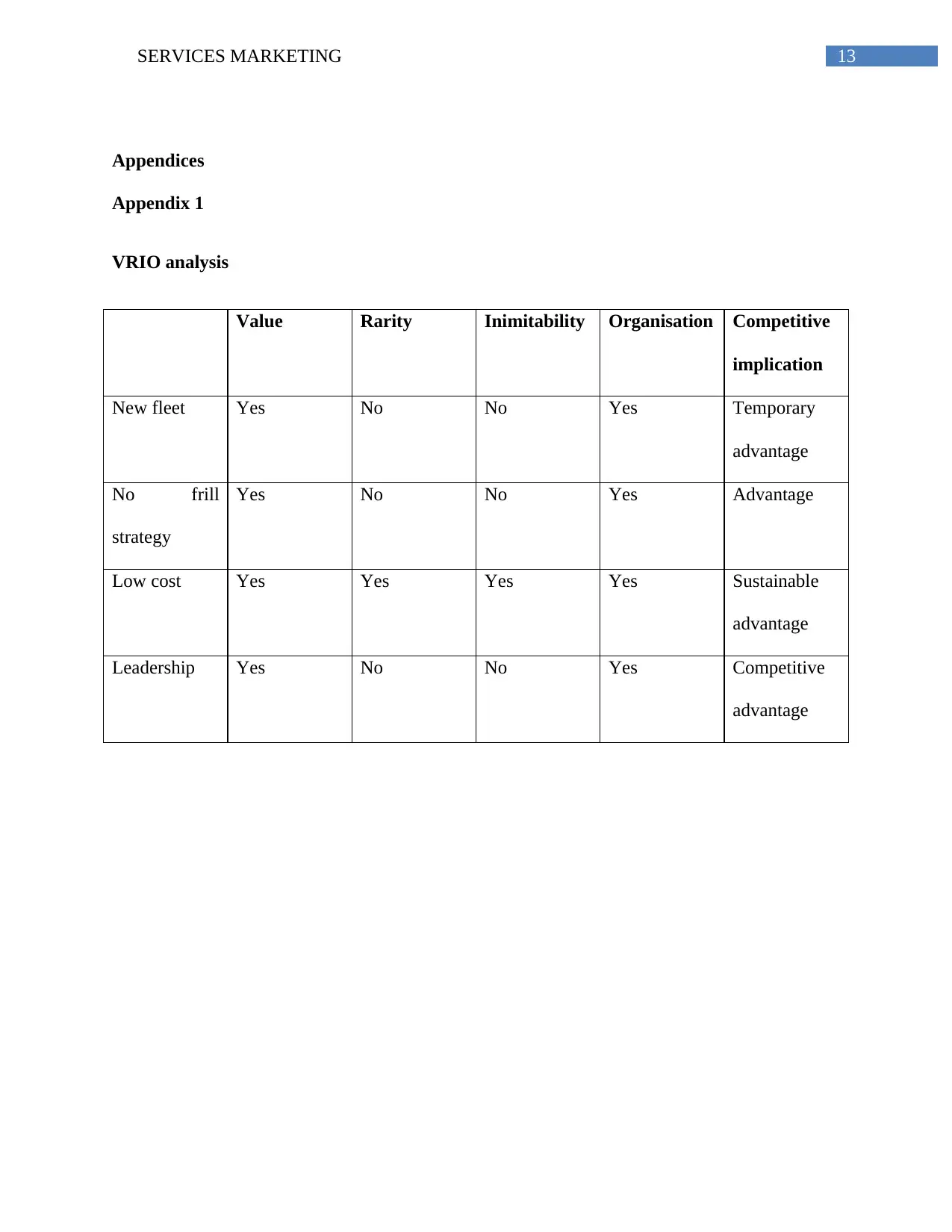
13SERVICES MARKETING
Appendices
Appendix 1
VRIO analysis
Value Rarity Inimitability Organisation Competitive
implication
New fleet Yes No No Yes Temporary
advantage
No frill
strategy
Yes No No Yes Advantage
Low cost Yes Yes Yes Yes Sustainable
advantage
Leadership Yes No No Yes Competitive
advantage
Appendices
Appendix 1
VRIO analysis
Value Rarity Inimitability Organisation Competitive
implication
New fleet Yes No No Yes Temporary
advantage
No frill
strategy
Yes No No Yes Advantage
Low cost Yes Yes Yes Yes Sustainable
advantage
Leadership Yes No No Yes Competitive
advantage
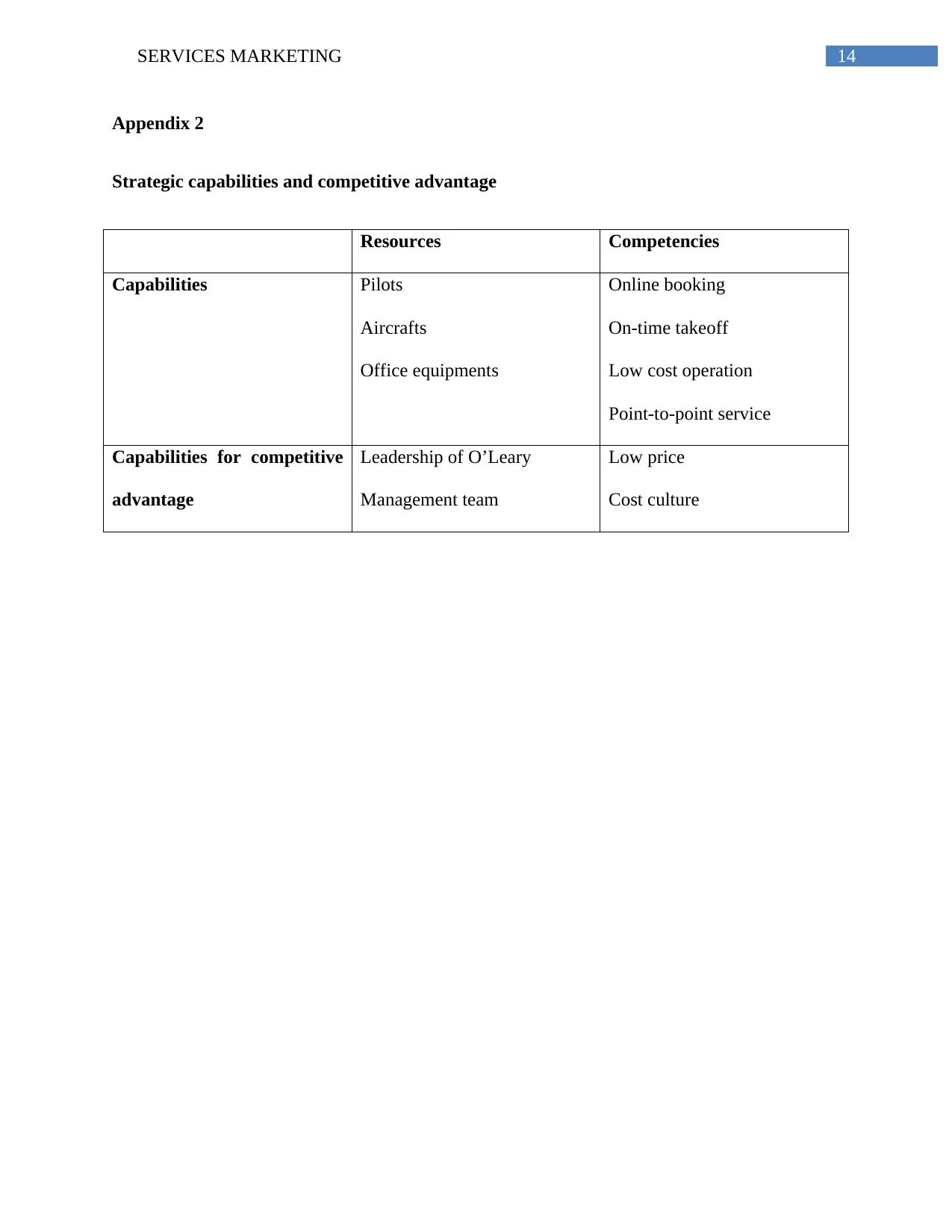
14SERVICES MARKETING
Appendix 2
Strategic capabilities and competitive advantage
Resources Competencies
Capabilities Pilots
Aircrafts
Office equipments
Online booking
On-time takeoff
Low cost operation
Point-to-point service
Capabilities for competitive
advantage
Leadership of O’Leary
Management team
Low price
Cost culture
Appendix 2
Strategic capabilities and competitive advantage
Resources Competencies
Capabilities Pilots
Aircrafts
Office equipments
Online booking
On-time takeoff
Low cost operation
Point-to-point service
Capabilities for competitive
advantage
Leadership of O’Leary
Management team
Low price
Cost culture
1 out of 15
Related Documents
Your All-in-One AI-Powered Toolkit for Academic Success.
+13062052269
info@desklib.com
Available 24*7 on WhatsApp / Email
![[object Object]](/_next/static/media/star-bottom.7253800d.svg)
Unlock your academic potential
© 2024 | Zucol Services PVT LTD | All rights reserved.





